Sofa covers are a great way to revive the look of your leather sofa without spending too much. But sometimes, they can be tricky to keep in place because of the slippery surface of leather material. If you’re looking for ways to make sure your cover stays put, this article is for you! We’ll answer some common questions, share useful tips and tricks, and ultimately help you keep your cover looking neat and tidy. So let’s get started!
Secure the sofa cover using tuckers, grips, or inserts

Step 1: Drape the cover over the sofa
First things first, drape the cover over the sofa and ensure it fits properly—it shouldn’t be too tight or too loose. If necessary, make adjustments to get the fit just right. It is important to do this before adding any tuckers or grips because these can cause permanent creases in your leather sofa if they are put in place while the fabric is already stretched out.[2]
Step 2: Place the sofa grips and inserts
Sofa grips and inserts are the best way to keep sofa covers in place on leather. They come in various sizes and shapes, so you can choose the one that fits your needs. To use them, simply slide them between the cover and the furniture, securing it firmly in place. You can also tuck a piece of fabric around the grip for extra security.[2]
Hold the sofa covers with furniture straps
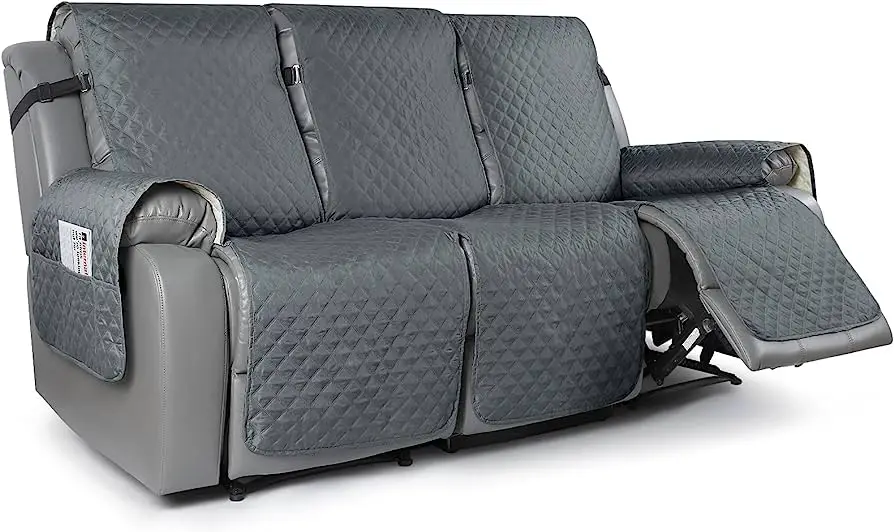
Step 1: Adjust the straps
Furniture straps are a great and reliable way of keeping your sofa covers in place on leather. To begin, adjust the straps to fit snugly around the furniture so that there is no loose fabric or slack. You may need to use more than one strap to ensure the cover fits securely. Make sure you attach the straps around each corner of the sofa for maximum stability.[2]
Step 2: Tighten the straps
Once you’ve adjusted the furniture straps to your desired size, it’s time to tighten them. Start by pulling each strap as tight as possible and then use a screwdriver or other tool to secure the buckles in place. Make sure everything is firmly attached before moving on.[2]
Using twist pins to hold the couch covers in place.
Twist pins are a great option to keep your sofa covers in place. These U-shaped pins make it easy to secure the fabric in place without causing any damage to your leather furniture. To use twist pins, carefully tuck the cover into the creases of the couch and then use a Phillips screwdriver or an awl to push the pin through both layers.
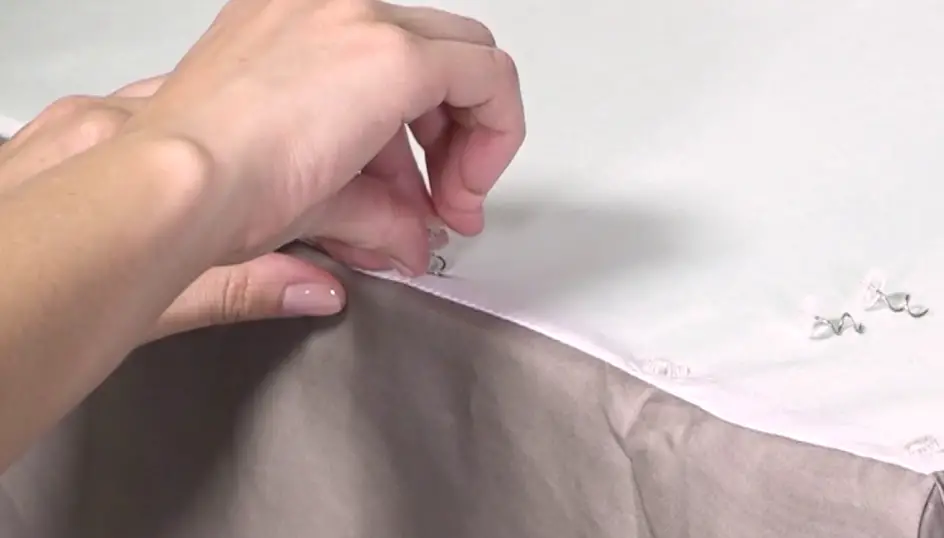
If you find that the pins are not enough to keep the cover in place, you can supplement with a few strategically placed strips of double-sided tape. The twist pins will help to keep everything together and the tape will ensure that no sliding occurs.[1]
Using Velcro to hold couch covers
Using Velcro to hold your couch covers in place is a great option. It is easy to attach, and it provides a secure fit that won’t budge once you’ve applied it. Make sure to use the right type of Velcro for leather – one with an adhesive backing specifically made for leather surfaces.
Once you’ve attached the Velcro onto both the couch cover and the leather, press firmly and allow plenty of time for it to properly adhere before putting any stress on it. This type of connection should last you a long time, as long as you take care in properly affixing it.[1]
Use Foam Sticks
One of the best ways to keep your sofa covers in place on leather is with foam sticks. These are thin strips of foam that you can stick onto the back side of your cover and they’ll act as a barrier between the cover and the leather surface, helping to prevent it from slipping and sliding. They’re also very easy to install – all you need to do is peel the adhesive backing off and press them in place.
Rug Grip Strips
Rug grip strips are the ideal solution for keeping sofa covers in place on leather. This simple tool is made from plastic and can be applied to the underside of the sofa cover. It features a series of grooves that grip onto the leather surface, preventing it from slipping off. The rug grip strips come in various sizes so you can find one that fits your sofa perfectly. To apply the rug grip strip, simply peel off the backing and adhere it to the underside of the cover.
You may need to use a bit of pressure to make sure that it’s properly secured in place. Once applied, your sofa cover should stay put![1]
Use Upholstery Pins
Upholstery pins are a great way to keep your sofa covers in place on leather. They come in many sizes and styles, so you can find the right ones for your needs. For example, if you need extra support for heavier fabrics, look for larger upholstery pins with longer shanks. Or if you need something more discreet, choose smaller pins that are less visible.
When using upholstery pins, make sure to insert them into the seam of your sofa cover and not directly into the leather. This will help prevent unnecessary damage to your furniture.
Also, be sure to place them at regular intervals so they can evenly distribute the tension from pulling on the fabric.[1]
Using Slipcover Straps
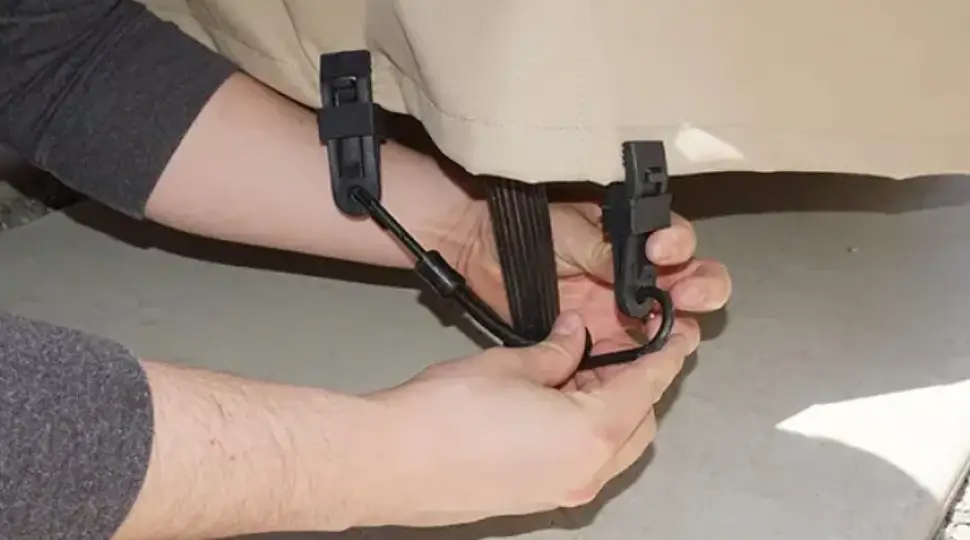
Using slipcover straps is one of the most effective ways to keep your sofa cover in place on leather. Slipcover straps are specially designed clips that attach directly to your leather sofa and hold the fabric in place. To use these straps, you’ll need to take some basic measurements. First, measure the length of each cushion from top to bottom. Next, measure the width of each cushion. Finally, measure the depth of the seat from front to back.
Once you have these measurements, you can buy the appropriate size slipcover straps for your sofa. When attaching the straps, make sure that they are spread evenly across the entire length and width of each cushion.[1]
Use Magazines
Using books and magazines can be surprisingly effective when it comes to keeping sofa covers in place on leather. Place the desired number of magazines or books along the length of your sofa where you’d like to keep the cover in place, then tuck the fabric over them. This simple trick will help weigh down any excess material while also providing an extra layer of protection from any slipping and sliding.
If you’re worried about your magazines or books getting damaged, you can always opt for the more temporary solution of using a heavy-duty tape as well. Be sure to test out both solutions before committing to one just in case.[1]
Sofa Tuckers Or Slipcover Tuck Grips
If you’ve tried all of the above tips and still find that your sofa covers keep slipping off, don’t worry! You can also use a product called ‘sofa tuckers or slipcover tucks grips’. These ingenious products make it easy to keep your sofa cover in place while adding extra cushioning at the same time.
Simply slip them in-between the fabric of your couch and the cushion, and they’ll give your cover a snug fit that won’t move around or bunch up. You can also use them to hold sofa cushions in place if you find them sliding around when people sit down.[1]
Use A Wooden Spoon
One of the simplest and most underused tips for keeping your sofa covers in place is to use a wooden spoon. Place it between the cover and leather surface when you are trying to fit the cover on properly. This will help to keep it from slipping off or bunching up in certain areas.
Use BedSheet Holder Straps
Bed sheet holder straps are an inexpensive and effective way to keep sofa covers in place on leather. These straps, which come in a variety of sizes, attach to the furniture frame with special clips that won’t damage your leather. The straps can be adjusted through several different loops around the cover and then fastened to the furniture frame for a snug fit. This is an especially good option for slipcovers that are prone to bunching up.[2]
Use Stretchable Couch Covers
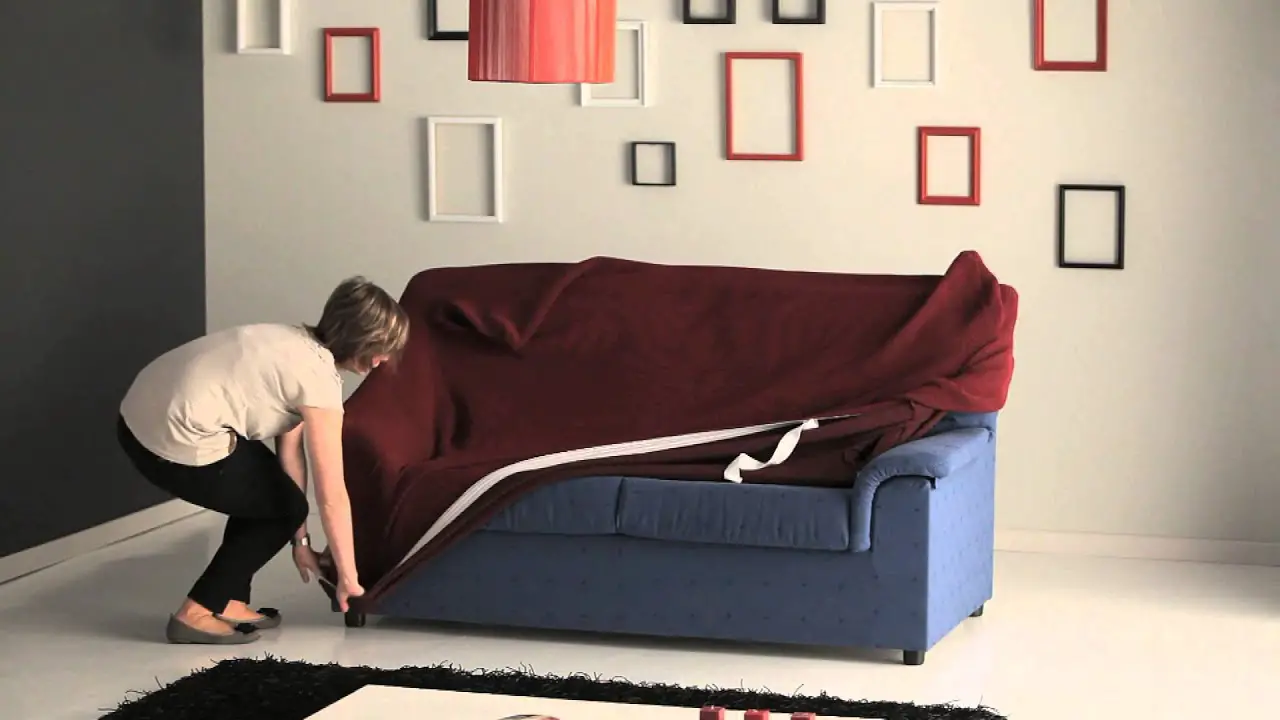
Stretchable couch covers come in a variety of fabrics, including leather-like textures. These covers are designed with an elasticized fit to hug your furniture securely, so they won’t slip or slide around. Stretchable covers also have the added benefit of being wrinkle and shrink resistant. Not to mention, they’re easy to put on—simply pull the cover over the sofa and tuck any excess fabric into the cushions.[2]
Using a Dowel Rod
Using a dowel rod is one of the easiest ways to keep your sofa cover in place on leather. Start by placing the dowel rod at the back of the cushion and slide it through the length of the sofa cover. This will help keep it securely in place so it won’t slip off or bunch up when you sit down.[2]
Tighten Drawstring
Drawstring slipcover will easily slide off a leather sofa unless you take extra steps to keep them in place. Start by making sure the drawstring is pulled tight and secure before sitting down on the sofa. Make sure you’re also pulling it from the outside of the cover rather than inside, so that the fabric doesn’t bunch up when you tie the knot.
You can also opt for a slipcover with extra-long drawstrings like elastic cording or ribbons, which will help to keep your cover in place even when you’re sitting down.[2]
Staple Gun
One of the most effective methods for keeping your sofa covers in place on leather is by using a staple gun. It’s an easy and fast way to secure fabric to the leather upholstery, ensuring that it won’t move around or slip off. All you need is some staples and a suitable staple gun for the job.
Before attaching the cover with a staple gun, it’s important to ensure that the fabric is laid down perfectly and fits snugly around the sofa. You should also make sure that any excess fabric is tucked or pleated so that it won’t bunch up when stapled down.[2]
How to cover a leather sofa to stop slipping
Step 1: Measure your sofa
Before you buy or make any covers for your leather sofa, it’s important to first measure the dimensions of the furniture. This will ensure that your chosen fabric fits properly and does not slip off or bunch up in certain areas when used.[1]
Step 2: Choose a non-slip cover
Once you have taken the measurements of your sofa, it’s time to shop for a non-slip cover. There are several types of fabric that work well for this purpose. Look for materials that are thick enough to stay in place but flexible enough to move with the contours of the leather. Cotton twill is one example; another is vinyl or leather-like fabric.[1]
Prepare the sofa
Before you put the cover on, it is important to prepare the leather. Clean the surface thoroughly with a mild detergent and a soft cloth. If there are any tears or cracks in the leather, fill them in with Leather Filler. Once you have done this, use Leather Conditioner to make sure your sofa stays supple and doesn’t dry out.[2]
Place the cover on the sofa
Once the leather is prepped, it’s time to put on the cover. Start by placing one end of the fabric over an armrest and stretch it gently over the back of the sofa. Be sure to tuck in any excess material along the sides and bottom so there are no gaps or bunches that can cause slipping later on.[2]
Smooth out the cover
Once the cover is in place, use a damp cloth to smooth out any wrinkles or folds. You may also want to use a steam iron for best results. This will help ensure that the fabric stays flat and fits firmly against the leather.[2]
Secure with tape
The final step in keeping your sofa covers in place on leather is to secure them with tape. Look for a heavy-duty double-sided tape that can be easily removed when you’re ready to change the cover. This will provide additional grip and make sure that your sofa cover stays securely in place.[2]
FAQ
How do you hold slipcovers in place?
Slipcovers are a great way to protect and refresh your leather sofa. To keep them in place, you may want to consider using furniture straps or tucking excess material into the cushions and sides of your couch. If your slipcover has ties, then tying those around the legs and arms of the sofa can also help keep it secure.
How do you secure a slipcover?
Using furniture straps is an easy way to secure a slipcover to your leather sofa. These straps, which are available in many sizes and colors, can be adjusted for a snug fit and prevent the slipcover from slipping off. Additionally, you may want to tuck excess fabric into the cushions or sides of the sofa.
How do you keep a slipcover from slipping on a leather couch?
In addition to furniture straps, you can also use tape or upholstery adhesive to keep your slipcover in place. Tape will work best on smooth leather, while an upholstery adhesive is best for textured leather. Additionally, if your slipcover has ties then tying those around the legs and arms of the sofa can help secure it and prevent slipping.
How do you stop slipcovers from pulling out?
One way to prevent slipcovers from slipping out is to use furniture straps. These straps, which come in a variety of sizes and colors, can be adjusted for a snug fit and help keep the slipcover securely attached to your leather sofa. Additionally, you may want to tuck excess fabric into the cushions or sides of your couch.
What are slipcover grips?
Slipcover grips are small straps that you attach to the bottom of your slipcover and affix to the sofa with adhesive. These grips help keep your slipcover in place and reduce movement, preventing it from slipping off or becoming displaced.
How long do slipcovers last?
The lifespan of your slipcover will depend on how often it is used, as well as the quality of the fabric. Generally speaking, high-quality slipcovers can last for up to three years with proper care and maintenance. Additionally, you may want to periodically inspect your slipcover for any signs of wear or damage that need to be addressed.
Useful Video: Recliner sofa cover installation
Conclusion
In conclusion, sofa covers are an excellent way to keep your leather furniture looking as good as new. They offer great protection against everyday wear and tear and make it easier to clean up messes. With the right care, they can last for years without fading or becoming loose. Follow the simple tips in this article, and you’ll be able to keep your sofa cover in place on your leather furniture for a long time. Now you can enjoy your leather sofa with a great looking cover and all the protection it offers. Thanks for reading!
References
- https://leatherinsights.com/how-to-keep-sofa-covers-in-place-on-leather/
- https://gorilla-rooms.com/how-to-keep-couch-cover-in-place/

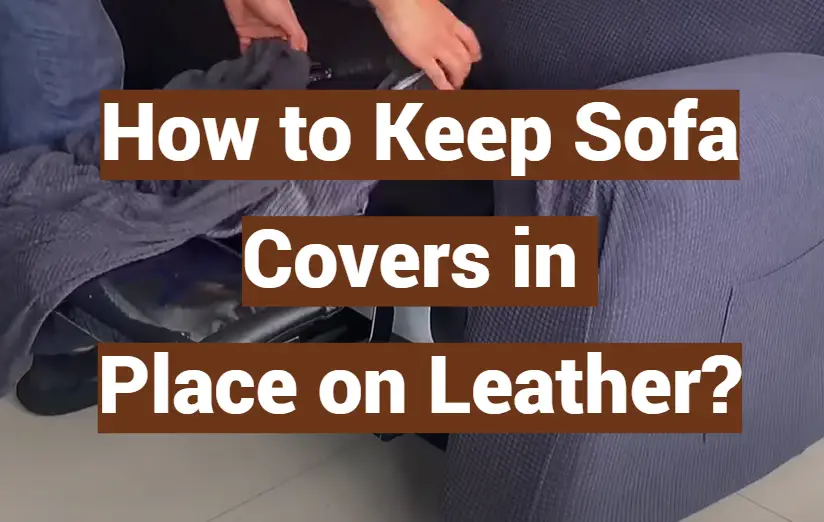


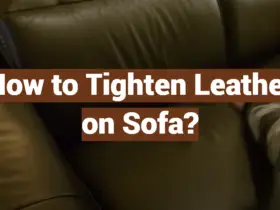


Leave a Reply